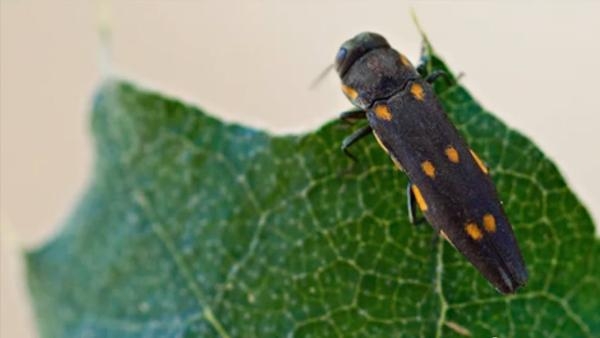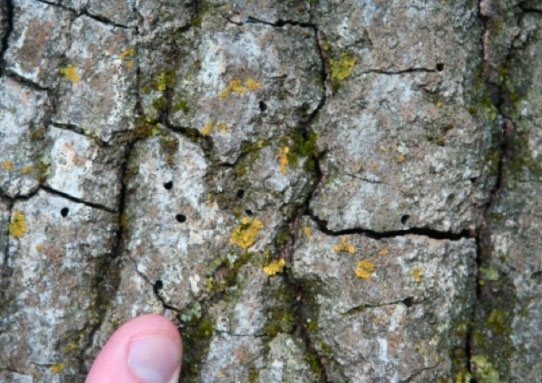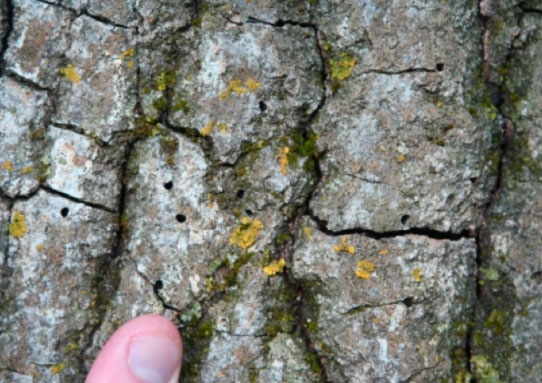Posts Tagged: GSOB
Movie star helps raise awareness about threats to California oaks
When actress René Russo appeared in a video (posted below) about “New Oak Threats,” she wasn’t acting. The veteran of big-budget thrillers like Lethal Weapon 3 and 4 and the Thomas Crown Affair expressed her personal convictions when she called for Californians to become educated and observant guardians of California oaks.
“I love our beautiful oak trees,” Russo said. “But there’s a new pest in town, and we could potentially lose every tree that we have. It would change the face of Southern California. It’s terrifying.”
The actress says the death of 80,000 oak trees in San Diego County since 2008 from goldspotted oak borer is one example of the devastation wreaked by one invasive pest.
“We need your help to save the trees,” Russo said.
The video presents the tell-tale signs of two serious threats to oaks - goldspotted oak borers (GSOB), which leave “D” shaped exit holes in the bark, and polyphagous shot hole borers (PSHB), which exit bark from small, black rimmed holes surrounded by wood discoloration.
Goldspotted oak borer, a native of southeastern Arizona, feed beneath the bark of certain oak trees. After several years, the damage to nutrient- and water-conducting tissue kills the tree.
Polyphagous shot hole borer carries a fungus from tree to tree when it burrows in bark to lay eggs. The fungus grows and spreads throughout susceptible trees. Some trees suffer branch die-back, while others are killed outright. The polyphagous shot hole borer is not only a threat to oaks but it can also affect more than 200 other tree species, including native California sycamore, avocado, and many popular street tree species.
“It’s really a whole landscape changer,” said certified arborist Rosi Dagit of the Resource Conservation District of the Santa Monica Mountains. “All of our street trees, our urban landscape trees and all of our wildland trees are at risk. What we really need are eyes on the ground.”
In the second half of the video, Sabrina Drill, UC Cooperative Extension advisor in Los Angeles County, explains what Southern Californians can do to protect trees.
- Visit the website Southern California Oak Pests (http://ucanr.edu/socaloakpests) to learn about the pests.
- Educate your friends, neighbors and community leaders about the pests.
- Don’t move firewood in and out of your local area. If you buy firewood, ask where it came from. On camping trips, burn wood you collect or purchase and don’t take any home. For more on firewood see the website Dontmovefirewood.org.
- Learn what to look for and report your observations on the Southern California oak pests website.
- Be an advocate for your trees.
“Hopefully, we can get this done,” Russo said. “We’ve lived with these beautiful oak trees for thousands of years. It would be devastating to lose them.”
The video, a joint effort of UC Cooperative Extension and the Resource Conservation District of the Santa Monica Mountains, was produced, directed and edited by Toby Keeler of Fine Cut Inc.
Watch the 10-minute video here:
More trees infested with goldspotted oak borer
Two more trees in Idyllwild are infested with goldspotted oak borer, reported the Riverside Press-Enterprise yesterday. The announcement came at a community meeting over the weekend, in which Tom Scott, UC Cooperative Extension specialist in the Department of Natural Resources at UC Riverside, and Kevin Turner, UC Cooperative Extension goldspotted oak borer program coordinator, joined fire and forestry officials to brief local residents about the new pest threat in the area.
Residents learned how to examine oak firewood this winter and how watch their black oaks and coast live oaks this spring for signs that they may harbor the insect. Firewood or trees suspected of being infested should be reported to (951) 659-3850, the story said. More information is available at the UC Cooperative Extension GSOB website.
Officials enlist mountain residents to battle goldspotted oak borer
Cal Fire, UC Cooperative Extension and other officials will be meeting with residents of Idyllwild tomorrow to enlist their help in stopping the goldspotted oak borers' tree destruction in the picturesque mountain community, reported the Riverside Press-Enterprise.
GSOB appears to have spread to Idyllwild by hitchhiking on firewood from San Diego, where it has killed some 80,000 oak trees. It has been found in only one tree in Idyllwild so far.
Tom Scott, UC Cooperative Extension specialist in the Department of Environmental Sciences at UC Riverside, and Kevin Turner, UCCE goldspotted oak borer program coordinator, will be among the speakers.
Meanwhile, ABC Eyewitness News in Los Angeles interviewed UC Riverside entomologist Vanessa Lopez about an effort to bring in GSOB predators to California from Arizona.
"What we're hoping to do is go to Arizona and find those insects that are specialized to only feed on goldspotted oak borer and they're efficient at controlling the population," Lopez said.

Small size but big destruction, the goldspotted oak borer. (Photo: UC Riverside)



